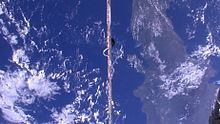High Definition Earth Viewing

High Definition Earth Viewing ( HDEV ) was a NASA experiment conducted on the International Space Station (ISS). These were four commercially available HD video cameras that observed the earth from April 30, 2014 and their images were transmitted as a live stream. On August 27, 2019, the system failed permanently; According to the NASA statement, it has "reached the end of its life".
functionality
The four cameras are permanently mounted in a housing. The device was transported to the ISS on April 18, 2014 with a Dragon spaceship as part of the SpaceX-CRS 3 mission . Then it was with the remote-controlled robot arm of the station at the Columbus laboratory of the ESA has been fixed. The cameras observed the earth from three different directions: two looked back, one forward, and one straight down. If the ISS just flew over the night side of the earth, the screen remained black. A gray screen indicated a camera change or appeared when the radio link from the ISS to Earth was interrupted.
Development and use
The HDEV system was developed at the Johnson Space Center in Houston and implemented together with students from the “High Schools United with NASA to create Hardware” program. The declared main objective of the HDEV mission was to investigate how the image quality of the cameras changes over time under the influence of extreme radiation conditions. Accordingly, the only protection used was a light insulation against the cold and a nitrogen atmosphere to simulate the earth's pressure conditions.
The didactic project Columbus Eye - Live images from the ISS in school lessons at the University of Bonn was involved in controlling and receiving the videos. On a website, the HDEV videos and images were or are being offered for download in addition to the stream. With the help of interactive materials for remote sensing in schools , the space flight of the German astronaut Alexander Gerst was accompanied in order to convey the topics of earth observation and space travel to schoolchildren .
Columbus Eye was funded by the German Aerospace Center (DLR).
Web links
- NASA's HDEV website
- Columbus Eye website of the University of Bonn and the DLR
Individual evidence
- ↑ Webcam in space: Space station ISS shows earth in live stream. In: Spiegel Online. May 11, 2014, accessed May 26, 2014 .
- ^ Susan Runco: High Definition Earth Viewing (HDEV). NASA, March 25, 2014, accessed May 26, 2014 .
- ↑ Website of the project "Columbus Eye - Live Images from the ISS in School Classes"
- ↑ Web portal with images from the international space station . General Gazette Bonn. May 17, 2014. Retrieved May 26, 2014.
- ↑ Rienow, A .; Hodam, H. & Menz, G. (2014): Columbus Eye - HD - Earth observation from the ISS. ( Memento from May 28, 2014 in the Internet Archive ) In: Joint conference 2014 of the DGfK, the DGPF, the GfGI and the GiN (DGPF conference proceedings 23/2014), article 112.


